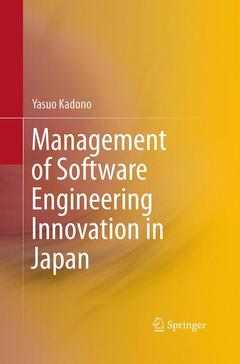Description
Management of Software Engineering Innovation in Japan, Softcover reprint of the original 1st ed. 2015
Author: Kadono Yasuo
Language: English
Publication date: 08-2016
Support: Print on demand
Publication date: 10-2015
173 p. · 15.5x23.5 cm · Hardback
Description
/li>Contents
/li>Comment
/li>
This book assesses the achievements of the software engineering discipline as represented by IT vendors in Japan in order to deepen understanding of the mechanisms of how software engineering capabilities relate to IT vendors? business performance and business environment from the perspective of innovation and engineering management. Based on the concepts of service science and science for society, the volume suggests how to improve the sophistication of services between the demand side, i.e., IT user companies, and the supply side, i.e., IT vendors, simultaneously.
The author and his colleagues developed a structural model including innovational paths, such as service innovation, product innovation and process innovation, and a measurement model including the seven software engineering capabilities: deliverables, project management, quality assurance, process improvement, research and development, human resource development and customer contact. Then they designed research on software engineering excellence and administered it with the Japanese Ministry of Economy, Trade and Industry and Information-Technology Promotion Agency. Through statistical analyses of the results, they found that human resource development and R&D are significant fundamental conditions to improve the quality of the deliverables and that IT firms with high levels of deliverables, derived from high levels of human resource development, quality assurance, project management and process improvement, tend to sustain high profitability. In addition, they developed a measurement model based on Porter?s five forces and Barney?s resource-based view. A regression tree analysis suggested that manufacturer spin-off vendors tend to expand business with well-resourced R&D, whereas user spin-off vendors tend to depend heavily on parent company demand.
These books may interest you

Green in Software Engineering 116.04 €

Green in Software Engineering 116.04 €


